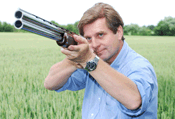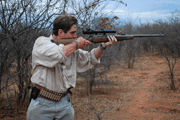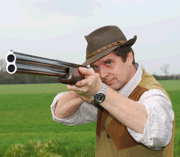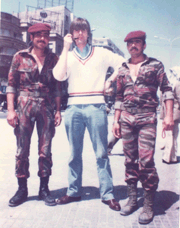Non toxic shot - Will Steel, Tungsten or Hevi Shot Damage My Gun by Mike Yardley
A Version of this article first appeared in the Field. My thanks to the editor. You can subscribe to the Field here.
The ecocrats don’t like lead and they appear to be planning to get rid of it.
Supposed that happened. What could we use instead? The viable alternatives are limited by the Periodic Table. Gold and silver would be ballistically acceptable but there are price problems. At present the options are steel (in fact soft iron), tungsten in various forms, and bismuth. All sorts of other things have been tried or considered – tin (still used in Scandinavia), zinc (withdrawn when its toxicity was discovered), copper, molybdenum powder mixed with plastic (though there is debate as to whether it was ever made), depleted uranium (better known as a tank killer and not without cost and environmental issues), and, believe it or not, wood. Non-metallic coatings for lead have also been developed. But, coated lead pellets are scuppered by current UK law which demands that non-toxic shot contains less than 1% of the wicked element Pb. Practically speaking, we are left with the three first mentioned options.
Don’t use steel in old English guns
What is safe to use in your gun? Ignoring its ballistic deficiencies, steel of any sort is not advisable for use in older English game guns. Pat Murphy, gun room manager of Holland and Holland, recently told me: “All our new guns are designed to be compatible with standard steel shot, but, as far as older English guns are concerned, we advise caution. We have modified a number of older guns to use steel at the request of customers. This would include lengthening the forcing cones – to ease the pressures and passage of the wad and shot into the main bore – and a reduction in choke constriction to a maximum of half. We do not routinely carry out these modifications, however. Nor do we sell steel shot cartridges because of their limited range and lethality. Our preference for classic guns is bismuth and suitable tungsten.” This is a view shared by many other knowledgeable members of the gun trade. It is also significant that no steel loads are available for 2 1/2" chambered guns – the chamber length of the vast majority of older English guns.
The greatest danger of damage with steel is to tightly choked guns with thin barrel walls (as vintage guns often have). The best non-lead ammunition options for traditional side by sides are, however, very expensive – Improved Bismuth (developed by Eley) is £25.50 for 25 and Tungsten Matrix (produced by Gamebore) is £27.50 a box. Tungsten matrix combines tungsten powder with a polymer binding agent, it is has a ‘structure memory’ returning to shape after compression, and is to be distinguished in particular from sintered tungsten formed by compression and heat which, because of its hardness, is unsuitable for classic guns (although it has applications elsewhere).
If you have a modern over and under or side by side, however, steel shot becomes a realistic and cost-effective option (accepting its ballistic limitations). Beretta note in their current user’s manual:
“The fixed choke barrels of the Beretta overs and unders and side by sides, as well as the SP (steel proof) Mobil choke and Optima choke tubes are designed for the use also with factory steel shot cartridges loaded to standard specifications. When firing steel shot cartridges with fixed choke barrels or Beretta Mobil chokes and optima choke tubes, the best results are obtained using open chokes (cylinder, improved cylinder and modified). When utilising steel shot full choke constrictions (full and improved modified) do not increase pattern density and will distort normal pattern density...increasing wear and tear of the barrels.”
That advice would apply to many other makes of modern gun. But, just to complicate our issue, it must now be noted that two sorts of steel cartridge may be encountered: ‘Standard Steel’ intended for use in guns which are normally proved (subject to checking the proof pressure compatibility with the particular cartridge pressure) and, ‘High Performance Steel.’ These types are defined by speed and momentum criteria set by CIP (the International Proof Commission). Practically speaking, steel cartridges over 32 grams using larger pellets are almost certain to fall into the High Performance category and thus may only be shot in guns which are specially proven and which bear the new CIP fleur de lys marks on the barrels (see picture).
Should we all use semi-autos?
Many wildfowlers are now buying 3 and 3 ½” chambered semi-automatics because they are High Performance Steel friendly and soak up recoil efficiently. These guns have been specifically designed for use with heavy payload steel shot which can, with modern slow-burn, low peak-pressure, propellants, give improved performance. They might do better as well if current CIP regulations did not limit both velocity and momentum (change is on the way). There are steel cartridges available in the States, meantime, which significantly exceed the performance of any on offer here (including so called High Performance Steel), but, they do so by exceeding the current CIP limits (which, of course, do not apply on the other side of the pond).
Don’t take this as my endorsement of steel, though. Frankly I don’t like to shoot it much (even through gas-operated repeaters). It has, in my experience, a sharper recoil characteristic than lead (because of its hardness and the greater volume of the cartridge case it takes up due to its reduced weight), it’s terminal ballistics are still less than perfect (and must – save in Roman Candle form – lead to more wounding). Its environmental impact is a matter for debate too: some suggest it is more of a problem than lead. It damages saw-mills once it gets into trees. It’s prone to ricochet. It can rust and create dangerous solid projectiles (less of a problem than it was). And, it may cause acid problems. There may be particular issues where steel and lead are mixed in soil.
Could steel damage my gun
What are the chances of your gun being damaged by non-toxic shot? Not great if you are prudent – or not unlucky. The essential problem is that steel and sintered tungsten pellets are very hard. They require wads – plastic or fibrous – which fully enclose the pellets as they move up the barrel and reduced choke (no more than half) because they do not compress/give as they pass through the muzzle. There have been, as non-toxic loads were in development, rather too many cases of wad failure. There may still be cases where shot is loaded too high which might have very expensive consequences if rogue pellets scrape the bore (consequently, it is folly to take a risk with a best gun, replacing the barrels of which might cost ten thousand pounds or more).
Both Eley and Gamebore fully warrant their specialist products for use in classic guns. I would only advise using cartridges where the manufacturer is willing to put their reputation on the line in this manner. Paul James of Gamebore notes enthusiastically of his company’s product, Tungsten Matrix (TM), for example: “There simply is only one non-toxic alternative available in the market for use in old English guns with characteristics that compare to Lead. Tungsten Matrix has a density of 10.8 compared to lead at 11. TM is safe to use through your favourite old gun with no consequences, it produces excellent patterns with density's being up to 92% at 40 yards, it is malleable like lead and can be used though any choke. We offer two types of wad – plastic and our patented fibre wad [imagine a small Smartie tube closed at one end], both are made in house and both totally enclose the shot as it passes up the barrel.”
Tungsten shot
Tungsten is much denser than steel (i.e its weight per unit volume is greater). Initial attempts to manufacture shot from it were not entirely successful, but several forms of tungsten shot are now viable. Eley in association with Royal Ordnance first announced “Blackfeather” tungsten in 1989. It was made by moulding tungsten powder with a plastic polymer. Eley have now ceased production and have concentrated their efforts on improving bismuth. Gamebore continue to work with tungsten, though, using a new nylon-based polymer as a binding agent. They call this product Tungsten Matrix. It has a density very close to lead’s at 10.8 g/cc (lead is 11.3, pure tungsten about 19). Their most popular duck load is the 12 bore Tungsten Matrix 5 shot, 30gm FSC in a 65mm (2 1/2”). This is specifically intended for use in classic guns (and was loaded a number of years ago for Holland & Holland).
Gamebore comment: ”we have been in the lead-free business for over 25years and have tried and tested a number of different metals with nowhere near the striking energy and characteristics that TM offers.” Tungsten Matrix is costly, but there seems little doubt with regard to it performance or its suitability for classic guns when suitably wadded. Tungsten matrix loses less residual kinetic energy than lead (because it deforms less) and packs a considerable terminal punch.
Hevi- shot
Lyalvale Express load Hevi-shot – an innovative US product which in its latest form is tungsten, nickel and iron with a polymer binder. It achieves an impressive density of 12 (more than lead). It uses less polymer than Tungsten Matrix, however, and is formed in a different way. Because of its high density, Hevi-shot can match, or better the ballistics of lead. Hevi-shot has won numerous Turkey shoots in the US where pattern concentration and pellet count on a paper target are all important. In the UK Hevi-shot is not loaded in a form suitable for classic guns yet, though in the US it is as Hevi-shot ‘Classic-Doubles.’ A new version of this may be imported soon; it will be warranted as safe for old guns as bismuth and tungsten matrix.
Tungsten Matrix and Hevi-shot are not the only tungsten options. Federal, the well know US ammunition manufacturers who did much work in developing tungsten polymer shot, created tungsten-iron shot (relative density 10) some years back. It was not based on a polymer mix but sintered. This method of manufacture, which creates a hard, non-compressible pellet, has also been adopted by others. Remington’s latest offering is tungsten bronze HD shot – sintered tungsten, bronze and iron. Winchester have also offered sintered Tungsten, and various others are being made in China (the surprising source of many non-lead pellets).
Ian Charlton, of the specialist company Clay & Game Reloaders based in Lincolnshire, makes some sage observations and adds another alternative to our growing list: “There are now many new types of non-toxic shot being made and becoming available on the market, both here and in USA. Most are based on powdered tungsten combined with iron and nickel as matrixes to give them density and longer range lethality. One of particular note is ITX PRESSED AND SINTERED which is based on iron and tungsten, but has a similar density to bismuth.” The latter is round with a cutting band around its circumference and does not fragment under pressure. The maker’s claim it can be used without bore protection so it can even be used in muzzle loaders. ITX is not yet being used by commercial cartridge manufacturers, but it may be soon as it appears promising.
Don’t shoot beyond 35 yards – or through a tight choke
What are the range limitations of the non-leads? If you use ‘Standard Steel’ loads as defined by CIP, it would be foolish to shoot much inside 20 yards with it (because you will spoil your game), and much beyond 35 (because you will likely wound it). Sensible advice for steel, moreover, is to use pellets two bigger than you would for lead. With regard to choke, no more than half should ever be employed; tighter constrictions will distort patterns and may damage your gun. Shoot birds beyond 35 yards requires that you either have to go down the big-payload/steel/semi-auto road (as the fowlers have done) or use an expensive alternative. Bismuth performs nearly as well as lead, though the pellets are not quite as heavy or as strong and may be more prone to flaking or fracture. This is less of a problem than it was as alloys have been improved. It is, nevertheless, good advice to but go up a pellet size because. Tungsten, probably the best performing of the non-lead options, presents shooters with more issues and choices [see box].
How much do these alternative cartridges cost? This is where non-lead options get really scary. Standard Steel starts from about £5.50 a box, High Performance Steel from about £7.50, Eley’s Bismuth starts at £22.50 (and up depending on payload) and tungsten over £30 depending on payload. If you go for bismuth or tungsten it might easily cost you £100 or more to fill a cartridge bag. When wildfowling, the cost of cartridges is not as significant as when shooting driven game, pigeons or vermin. We might also consider the implications to clay shooting. If lead were banned, sporting clay shooting would become a very different game. The challenging, rangy, birds seen at today’s shoots would have to go – you just can’t hit them consistently with steel. Some forms of trap shooting would be severely affected too. The question of potential lead pollution in the ground might also be visited if a lead ban on clays appears (this is what has happened abroad). It’s not a happy picture.
Would the price of guns fall?
What would be the effect on capital values of good guns? I have discussed this with many members of the gun trade. Off the record, nearly everyone admits that a ban on lead would probably hit the value of capital guns. Any fall might be limited to some extent because the market value of best guns is maintained predominantly by those outside the UK. They also note that a ban on lead might stimulate new gun sales to a degree.
Would high-bird shoots suffer?
What will happen to high-bird shoots? This is another interesting question. High bird shooting is likely to become ever more expensive, as indeed, all shooting will when filling a cartridge bag with tungsten (the best high bird option) is likely to cost a hundred quid or more. People who shoot high birds regularly may be able to afford the extra, but, I think the greatest effect may, in fact, be on those hard-pressed ordinary mortal who attend more typical driven shoots. A ban on lead would significantly change British shooting sport, and would probably lead to new styles of sport developing and/or a return to older methods. More shooting over dogs? Perhaps. Less intensive rearing and more wild birds? Possibly. But, that is looking at the potentially positive. The great negative is that many may – because of hugely increased cost – give up shooting altogether, and that’s bad for all of us.
The law on non-toxic shot
The movement towards non-toxic shot began about a generation ago. Some studies suggested that there was evidence of lead poisoning in wildfowl and this lead to further research and political action. A ban on lead shot for wildfowling has been in place in the USA since 1991 (with a ‘phasing in’ stage beginning from the 1987-88 hunting season). It is also notable that in several European countries, notably Holland, Sweden and Denmark, there are prohibitions on the use of lead shot for game shooting as well as wildfowl. Happily this has not yet happened in the UK, but we have become a contracting party to the Agreement on the Conservation of African-Eurasian Migratory Waterbirds (AEWA), a multi-national conservation convention which came into full force in November 1999. AEWA covers 255 species and 118 countries (of which 63 were fully signed up as of February 2010). DEFRA is likely to undertake a full review of the British regulations soon and monitor the compliance with them.
A voluntary ban on lead for wildfowling and wetlands began in England and Wales in 1995. This became a matter of law in 1999. As the legislation for England and Wales stands today, the use of lead shot is prohibited on the foreshore, on about 300 specified sights of scientific interest (SSSIs), and for the shooting of wildfowl (including coot and moorhen) anywhere. There are differences in the law across the UK, however. In 2002, the Welsh Assembly introduced similar legislation to that in England and Wales. In Scotland and Northern Ireland, which legislated later; the use of lead shot is banned on wetlands as elsewhere in the UK, but there are exemptions which relate to peat habitats and to areas which are only occasionally wet. The legislation is area specific rather than species specific. BASC, its regional offices, and website (www.basc.org.uk <http://www.basc.org.uk/> ) is a good source of more precise information.
Charlie Bull of Just Cartridges, one of the UK’s biggest suppliers to game shooters states:
“The choice, cost and performance issues of non-toxic shot make it a veritable minefield. Sales of steel loads are buoyant for the very simple reason that they are now cheaper than lead; but I am not keen on the grounds of performance and the fact that their use can never be universal with all hardware. My personal choice would be Gamebore’s Impact Tungsten Matrix because the shot is malleable (like lead) and therefore deforms more on impact, creating maximum trauma and so better kills. Yes it is expensive, but with no cost effective alternative, it will do the job. If the writing is on the wall, there is a lot of work to do to find a practical cost effective alternative to lead. Trouble is, can the wheel be re-invented? It hasn’t been so far."
It this article worries you, it should. If you have concerns about the continued use of lead shot – and you should - you need to write or email the chief executives of the BASC, the Game and Wildlife Conservation Trust, the Countryside Alliance and the Clay Pigeon Shooting Association right now and ask them what their plans are.
A Version of this article first appeared in the Field. My thanks to the editor. You can subscribe to the Field here.






